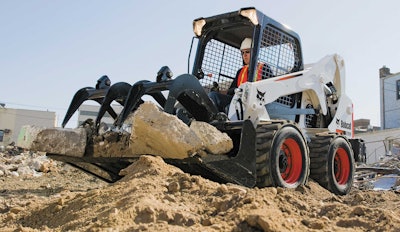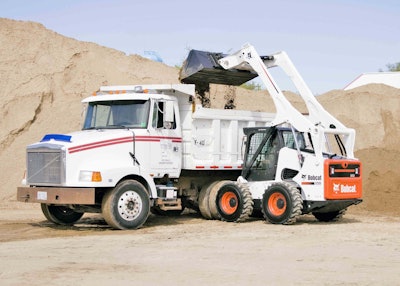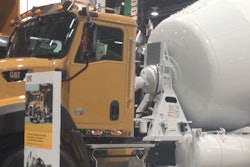 Bobcat S650 skid steer with industrial grapple
Bobcat S650 skid steer with industrial grappleWhether you’re a long-time skid-steer loader owner/operator, or are in the market to enhance your equipment fleet and offerings, there is no question that matching the machine to the job should be a top consideration. It’s a first step that will offer increased efficiency and uptime, as well as easy regular maintenance. In addition, skid-steer loader attachment options offer a versatility that’s hard to match.
“It used to be that you either had a very large machine and a shovel, but nothing in between,” says Mike Fitzgerald, Bobcat loader product specialist. “Compact equipment, like skid steers, makes an operator’s job immensely efficient and eliminates a lot of manual labor.”
Features and benefits
When choosing a skid-steer loader, be sure to let the dealer know exactly what the machine will be used for. Do you need something that fits well in tight spaces, like residential back yards, or do you have plenty of room on new construction sites? Are you picking up material and loading it into a truck, requiring extra lift and reach, or are you doing final grading work? These are all important parameters that help a dealer best understand your needs.
“Compact equipment …makes an operator’s job immensely efficient and eliminates a lot of manual labor”
The environment the machine will be working in is another important consideration, including dust and debris in the summer, or cold, snowy conditions in the winter. Pressurized cabs provide the operator excellent protection from the elements, while maintaining a comfortable temperature inside the cab.
Best operation/maintenance practices
When it comes to operation and maintenance of a skid-steer loader, “it’s always best to first and foremost follow the manufacturer’s instructions that come with the machine,” Fitzgerald says. “Match the machine to the job. Don’t try to load the bucket beyond its rated capacity. If you’re using hydraulically powered attachments, like a breaker, be sure the auxiliary flow is within the appropriate range for the breaker.”
 Bobcat S850 skid-steer with bucket
Bobcat S850 skid-steer with bucketFollowing the recommended operation and preventative maintenance guidelines will ensure a machine performs efficiently and hopefully ward off any unnecessary repairs, minimizing costs. Machine performance varies based on who is operating the equipment, so Fitzgerald suggests that if a foreman or owner notices one person operating more effectively versus another to find out what the differences are and implement those efficiencies when training new operators.
Fleet management
Fleet management practices often depend on the owner and their business practice preferences. In the end, it comes down to efficiency and job costs. Bigger pieces of equipment move more material in a shorter amount of time than a smaller machine. For site preparation or new construction, a large machine might be the best option to move material quickly. However, in more confined areas or on established jobsites a smaller machine might be the most efficient because it reduces manual labor and is easy to fit in and get out.
In addition, fleet management can include the upkeep and information about an owner’s equipment.
Attachment versatility
Access to a wide variety of skid-steer attachments eliminate the need to subcontract portions of a larger job and adjust to changing markets, applications or multiple jobs.
The breadth of attachments also provide the option of year-round operation and enable the operator to utilize the skid steer in various applications through low initial investment with great return. If a one-off job opportunity comes along, it’s easy to rent an attachment, and in most applications compact equipment coupled with attachments work as well or better than dedicated machines.
“Compact equipment can do 80 percent of the work,” Fitzgerald says. “You can make a profit as long as you have the machines and attachments to complete the job.”
Editor’s Note: This article was edited from materials provided by product experts at Bobcat.












